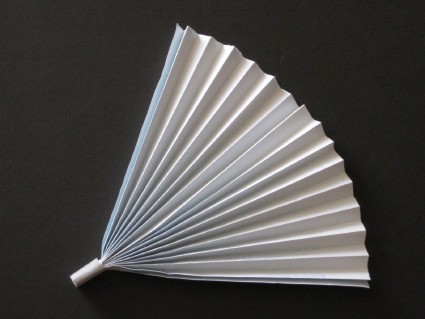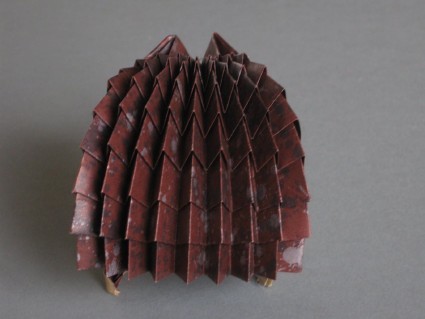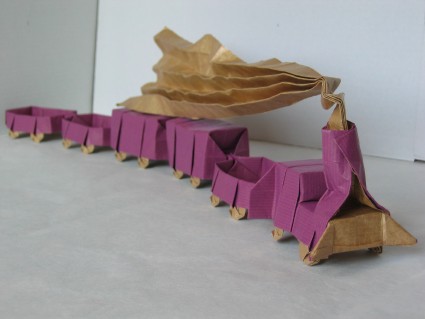
 | Welcome on MOOC-invitation |
|
| New! | An invitation to practice origami | map | Discovery of the world of folding paper Some major topics of folding paper |
| Back MOOC1 | Journey 2 | Sequence 3 | <--- page 6 | page 7 | page 8---> |
 |
Box pleating |
| The discovery of box pleating was a real revolution. This technique, credited for the first time during the creation of the Mooser train, makes it possible to build as many appendices as necessary, sizes and arrangements of any kind, with a single sheet of paper, without cutting. The basic principle is the use of series of valley-mountain folds which make it possible to form a point. For example, to get a range, simply create a succession of valley folds then mountain parallel to an edge of a sheet, usually equidistant. The more folds you make, the slimmer the fan will be. Box pleating is usually based on an orthogonal grid. The folds are then made with diagonal folds that bring the horizontal or vertical folds closer to each other. You will find below some steps of folding hedgehog of Yudai Imai . This is a true case study of box pleating, which is based on a 32x32 grid. Box pleating has become an essential tool for modern paper folding. Many creators use it almost systematically to create models of great complexity. Enjoy the few photos that accompany this text! |
19 photo(s)
 Eventail
Lionel Albertino
Eventail
Lionel Albertino
|  step 10, grid 32x32
step 10, grid 32x32 |  step 18
step 18 |
 step 19
step 19 |  step 21
step 21 |  step 22
step 22 |
 step 36
step 36 |  step 46
step 46 |  step 53
step 53 |
 step 54
step 54 |  step 54 completed
step 54 completed |  Hedgehog completed
Hedgehog completed |
 Hedgehog, back view
Hedgehog, back view |  Mooser's Train
Robert J. Lang
Mooser's Train
Robert J. Lang
|  Tren
José Angel Iranzo
Tren
José Angel Iranzo
|
 Glaucus atlanticus
Andrey Ermakov
Glaucus atlanticus
Andrey Ermakov
|  Flamingo
Yasushi Miyashita
Flamingo
Yasushi Miyashita
|  Zinnia
Aldo Marcell
Zinnia
Aldo Marcell
|
 portion de diagramme de pliage accordéon, Terry08 p. 83, modèle de Fernando Gilgado
portion de diagramme de pliage accordéon, Terry08 p. 83, modèle de Fernando Gilgado |